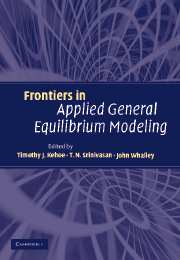Book contents
- Frontmatter
- Contents
- List of Contributors
- Acknowledgments
- Introduction
- Part One General Equilibrium Theory
- Part Two Computational Methods
- Part Three Macroeconomics and Finance
- 5 Nonconvexities in Quantitative General Equilibrium Studies of Business Cycles
- 6 Lotteries for Consumers versus Lotteries for Firms
- 7 Default and Aggregate Fluctuations in Storage Economies
- 8 New Applications of General Equilibrium to Finance: Default and Collateral
- Part Four Public Finance, Development, and Climate Change
- Part Five General Equilibrium Restrictions and Estimation of Hedonic Models
- Part Six Policy Uses and Performance of AGE Models
- Index
5 - Nonconvexities in Quantitative General Equilibrium Studies of Business Cycles
Published online by Cambridge University Press: 14 January 2010
- Frontmatter
- Contents
- List of Contributors
- Acknowledgments
- Introduction
- Part One General Equilibrium Theory
- Part Two Computational Methods
- Part Three Macroeconomics and Finance
- 5 Nonconvexities in Quantitative General Equilibrium Studies of Business Cycles
- 6 Lotteries for Consumers versus Lotteries for Firms
- 7 Default and Aggregate Fluctuations in Storage Economies
- 8 New Applications of General Equilibrium to Finance: Default and Collateral
- Part Four Public Finance, Development, and Climate Change
- Part Five General Equilibrium Restrictions and Estimation of Hedonic Models
- Part Six Policy Uses and Performance of AGE Models
- Index
Summary
ABSTRACT: This paper reviews the role of micro nonconvexities in the study of business cycles. One important nonconvexity arises because an individual can work only one workweek in a given week. The implication of this nonconvexity is that the aggregate intertemporal elasticity of labor supply is large and the principal margin of adjustment is in the number employed – not in the hours per person employed – as observed. The paper also reviews a business cycle model with an occasionally binding capacity constraint. This model better mimics business cycle fluctuations than the standard real business cycle model. Aggregation in the presence of micro nonconvexities is key in the model.
INTRODUCTION
The tool now used to study business cycles is the discipline of quantitative dynamic general equilibrium. In this discipline, given the question or issue at hand, an explicit model economy is written down and the answer to the question determined for that model economy. Theory, the question, and the available statistics dictate the choice of model economy used in the application. The pioneers in applying the discipline of quantitative general equilibrium are Herbert E. Scarf's students Shoven and Whalley (1972). They applied these tools to problems in public finance. Their models are rich in sector detail, but not truly dynamic. Subsequently Auerbach and Kotlikoff (1987), Jorgenson and Yun (1990), and others have made these public finance models dynamic.
A convenient feature of these early structures is a parametric set of excess demand functions that can be easily calibrated using input–output tables and the equilibrium computed using Scarf's algorithm or other solution methods.
Information
- Type
- Chapter
- Information
- Frontiers in Applied General Equilibrium ModelingIn Honor of Herbert Scarf, pp. 95 - 118Publisher: Cambridge University PressPrint publication year: 2005
Accessibility standard: Unknown
Why this information is here
This section outlines the accessibility features of this content - including support for screen readers, full keyboard navigation and high-contrast display options. This may not be relevant for you.Accessibility Information
- 2
- Cited by
